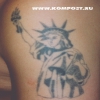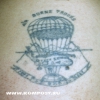

Military
|
Not having a lot of facts about the pre-Soviet military tattoo, we still can state that it existed in the Navy in the 19th century, not only among ordinary people, but among the shocking aristocracy. During the Great Patriotic War, the tattoo had a brief renaissance, being widely used and popular in the army and navy. The authorities at the time closed thier eyes on that sort of manifestation and tribute to the memory of fallen comrades, but in the Hrushchev period, when the tattoo started to penetrate the Soviet way of life through a passion for criminal and hooligan romance, began another wave of condemnation and the imposition of the myth that this was an exceptional attribute of the criminal environment. Despite the support of the myth of the incompatibility of the appearance of the Soviet person and this kind of decoration, the tattoo got firmly stuck in the urban folklore, that at some point was reflected in a considerable number of shotes in the movie of Danelia "Seryozha". For the period of the 80’s, tattoos in the army were banned (some cases of forced reduction are known), and in addition there was a circular on preventing the recruitment of young people having tattoos denigrating the dignity of the Soviet man. During the collapse of the Soviet Union in military enlistment offices without asking questions such holders were sent directly to the survey in mental hospitals. But, despite this, the tattoo continued to exist in the criminal, courtyard and army world (especially in the navy, border and landing Troops), wore the same low-tech nature of an amateur until the appearance of the subculture tattoo, which became the engine of progress in the world of body graphics and highly modifyed the old tradition.  go back to "Tattoo" go back to "Tattoo" |






